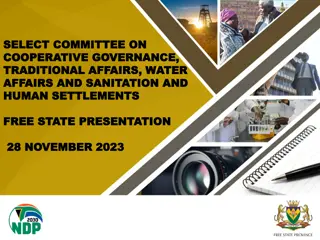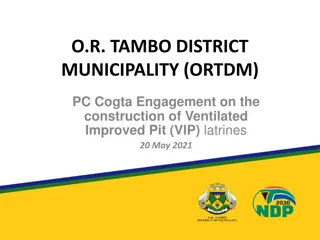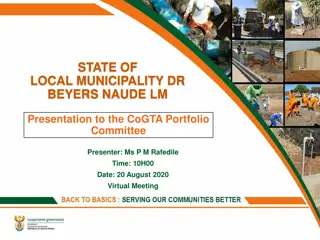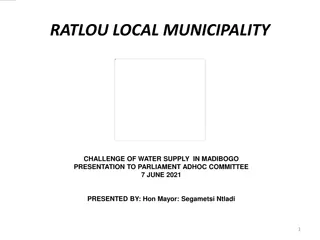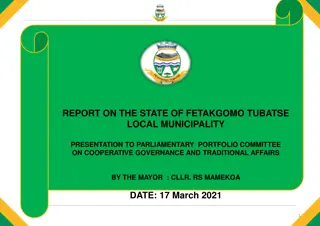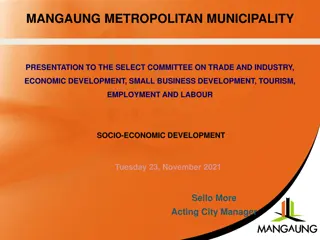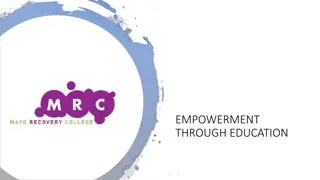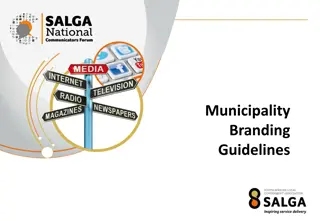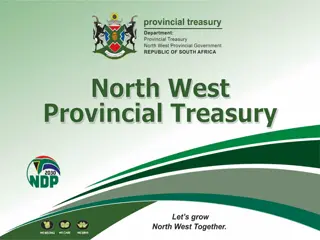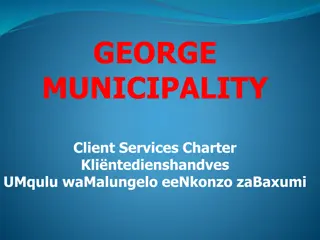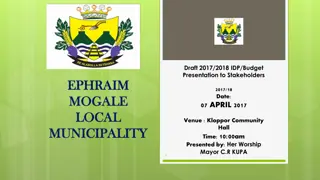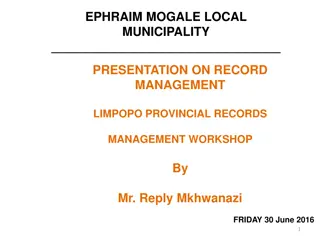Financial Recovery Plan Workshop for Mangaung Metropolitan Municipality Overview
The presentation outlines the purpose of engaging the municipal council in a draft mandatory Financial Recovery Plan (FRP) for Mangaung Metropolitan Municipality. It covers the background of the municipality's financial crisis, the national intervention invoked, and the revised approach to FRP development focusing on four key pillars: Finance, Governance, Institutional Development, and Service Delivery. The presentation underscores the importance of council's role in implementing the FRP for financial restoration and improved service delivery.
Download Presentation

Please find below an Image/Link to download the presentation.
The content on the website is provided AS IS for your information and personal use only. It may not be sold, licensed, or shared on other websites without obtaining consent from the author.If you encounter any issues during the download, it is possible that the publisher has removed the file from their server.
You are allowed to download the files provided on this website for personal or commercial use, subject to the condition that they are used lawfully. All files are the property of their respective owners.
The content on the website is provided AS IS for your information and personal use only. It may not be sold, licensed, or shared on other websites without obtaining consent from the author.
E N D
Presentation Transcript
PRESENTED BY: FRP MUNICIPAL COUNCIL WORKSHOP National Treasury MFRS 22 June 2023 Mangaung Metropolitan Municipality
2 Contents of the presentation The Purpose and background 01 Project Approach ( 4 work streams ) 02 Presentation for four pillars Finance, Governance, Institutional development and Service Delivery 03 Oversight and Monitoring 04 Institutionalisation of the FRP 05 Way forward 06
PURPOSE OF THE PRESENTATION To engage the MMM Council on the draft mandatory Financial recovery plan including : (a)The key findings emanating from a detailed status quo assessment; and (b)Proposed strategies and measures necessary to restore the financial health and improve service delivery in MMM. 1. To emphasize Councils role and responsibilities in the implementation of this FRP once approved. 2.
4 BACKGROUND The Mangaung Metropolitan Municipality met the jurisdictional facts as outlined in section 140 of the MFMA for a mandatory intervention to be invoked. This is due to its crisis in its financial affairs, serious and persistent material breach of its obligations to provide basic services and/or failure to meet its financial commitments. A national intervention was invoked by Cabinet on or about April 2022 in the Municipality due to the failure of the provincial mandatory intervention. The national intervention entails imposition of a Mandatory Financial Recovery Plan and assumption of responsibility to implement the imposed financial recovery plan through an appointed National Cabinet Representative and the support team. In terms of section 141(2) of the MFMA only NT MFRS may prepare a Mandatory FRP. Consultative meetings, working sessions with respective senior management officials and workstream meetings were held to conduct a comprehensive diagnostic analysis on the root causes of failures in service delivery and the prevailing financial crisis. A Status Quo Assessment report and draft FRP has been prepared in terms of the provisions of Chapter 13 of the MFMA. Once approved by the Minister, the FRP will bind the municipality in the exercise of its legislative and executive authority to the extent necessary to achieve the objectives of the recovery plan.
5 THE REVISED APPROACH TO FRP DEVELOPMENT The NT MFRS use a Status Quo Assessment Framework to assess key elements of the 4 Municipal Sustainability Pillars of Governance, institutional, Financial Management and Service Delivery. NT MFRS working with 4 workstreams, one for each pillar with municipal staff and stakeholder participation. Distinguishes between 3 distinct but interrelated phases. Purpose: to facilitate better/easier implementation and improve oversight and monitoring Minimal set of key indicators across all four pillars necessary to neutralise financial turbulence (6-8 months): Focus is on cash and short-term liquidity: Funded Budget, Cost Containment, Cash Flow Management, Trading Debtors and collections, Creditor Management, Cash-backed CGs Include service delivery projects with high visibility such as streetlights and potholes RESCUE Phase 1 To address the underlying causes of failure focusing on eradicating problems at the root (8-24 months): Plugging the holes and fixing the leaks STABILISATION Phase 2 To ensure financial and service delivery sustainability and prevent a regression (Subject to progress in Phase 2) SUSTAINABILITY Phase 3
6 PROJECT APPROACH IN PREPARING THE SQA Focus Area 1. Pillar 1 Governance a. b. c. d. e. Status update Problem / Key issues Key challenges Root causes Intervention to resolve matters 2. Pillar 2 Institutional and Human Resource 3. Pillar 3 Financial Management 4. Pillar 4 Service Delivery
7 THE STATUS QUO ASSESSMENT In developing this financial recovery plan, the following information sources were utilised: The Status quo assessments Previous FRP s Audit reports by the Auditor-General of South Africa. The Mid-year Budget and Performance Assessment Report and the Medium-Term Revenue and Expenditure Framework (MTREF) Budget. The Integrated Development Plan Financial Ratios in accordance with MFMA Circular 71 Annual Report The Annual Financial Statements Website Other documents per FRP checklist The NT MFRS assessment framework followed
8 To ensure service delivery and financial stability and sustainability the follow KEY activities are proposed PILLAR 3: FINANCIAL MANAGEMENT Refer to detailed assessment
9 PILLAR 3: FINANCIAL MANAGEMENT KEY RATIOS 2021/22 AUDITED RATIO NORM REMARK Maintenance of key assets is not prioritised. Lack of asset maintenance is leading to infrastructure breakdowns and service delivery limitations. Assets are rapidly deteriorating at an unsustainable rate. Repairs and Maintenance to PPE 8% 1.60% The estimated rand value is in excess of R242 million (2021/22) and could be the single biggest contributor to unmitigated increases in the Eskom debt. These losses are over and above the impact of poor debt collection of billed amounts. Electricity Distribution Losses (%) 7-10% 10.96% The estimated rand value is in excess of R 407 million (2021/22). This could be attributable to the internal usage not being accounted for, illegal connections, unbilled consumption, and lack of monitoring of water supplied by Bloem Water. The ratio questions the ability of the Municipality to set affordable tariffs, bill correctly and ensure what is billed is collected. The debtors book continues to grow without a solution. Water Distribution Losses (%) 15-30% 45% Annual revenue collection rate 95% 79.44% Gross debtor balances are escalating at an alarming rate. Poor credit control and lack of debt collection have led to severe cash flow limitations inhibiting the quality and level of service delivery. Debtor days 30 Days 88.15 Days The instances of Irregular expenditure are extensive. When the ratio is calculated by excluding non-procurement-related expenditure (eg. Depreciation, Employee cost etc.) and incl capital expenditure it increases to nearly 30% of procurement!!! Irregular Expenditure as % of Total Operating Expenditure 0% 18% Revenue growth reflects an improvement over the last financial year, with the growth rate above inflation. CPI Revenue growth 8.69% (4,5%-6%) The creditor payment period has been declining over the 3-year period. However, the days are in excess of the norm indicating that suppliers are not being paid within 30 days. Creditor Payment days 30 Days 115 Days Remuneration (Councilor Remuneration and Employee Related Costs) as % of Total Operating Expenditure The ratio is within the norm at 25%. There is room to fill critical vacancies to increase capacity and skills levels, but only if it can be afforded and in line with improvement in the cash flow position of the Municipality. 25-40% 24.71%
10 CASH POSITION TARGET TARGET TARGETS: TARGETS: Description 2022/23 2023/24 2024/25 2025/26 Bank Balance 30 June 2022 741,000, 000 Service Charges and Property Rates Collected (See 5,321,063,863 6,231,105,328 6,916,251,222 7,274,429,822 Assumption Table for collection rates) Other Revenue - Rental of facilities and equipment 56,261,509 58,793,277 61,438,975 64,203,729 (Assumed 100% Collected) Other Revenue (Assumed 100% Collected) 666,156,379 696,133,416 727,459,419 760,195,09 Grounded on adherence to the above budget parameters, it is anticipated that the Municipality s cash surplus of R 741 million at the end of the 2021/22 financial year will increase to a cash surplus of R 5,36 billion at the end of the 2025/26 financial year. It should be noted that this cash surplus is before capital and finance investments. Other Revenue - Grants (Assumed 100% Collected) 937,281,278 979,458,935 1,023,534,587 1,069,593,644 Interest earned - external investments 19,453,009 20,328,394 21,243,172 22,199,115 Total Cash Inflow 7,000,216,039 7,985,819,352 8,749,927,378 9,190,621,404 Note: We have excluded interest on outstanding debtors as recovery is not certain. Cash Expenses (Excluding Debt Impairment and 6,166,500,686 6,443,993,216 6,733,972,911 7,037,001,692 Depreciation) Finance charges 123,263,682 128,810,548 134,607,022 140,664,338 Total Cash outflow 6,289,764,368 6,572,803,765 6,868,579,934 7,177,666,031 Creditor repayments/ settlements - Trade payables and . 200,000,000 300,000,000 400,000,000 500,000,000 bulk services backlog Net Cash Outflow/Inflow from Operating Activities 510,451,671 1,113,015,587 1,481,347,443 1,512,955,373 Cash on hand before investing and financing activities 1,251,451,671 2,364,467,258 3,845,814,702 5,358,770,075
11 PILLAR 3: FINANCIAL MANAGEMENT FOCUS AREA TOP FINDINGS FRP STRATEGY/ SOLUTION During the 2020/21 and 2021/22 financial years, MMM budgeted Prepare, approve, and implement a Budget Funding Plan for the MTREF Funded surpluses of R 1,035 billion (2020/21) and R 622,7 million (2021/22). period linked to the FRP strategies and financial targets (NT Support). Budget and The financial results for the two years reflected deficits of R 20,2 million Progress must be reported monthly and include targets as KPIs in Budget (2020/21) and a deficit of R 872,7 million (2021/22) which clearly performance plans. Spending indicate that the budgets were not funded. Compile realistic cash backed budgets going forward. Limits Poor budgeting techniques and insufficient provision for the Provide realistic allocations for the provision for debt impairment. impairment of bad debt are the main contributors. In 2021/22 in Ensure cost reflective tariffs and scrutinise expenditure for unnecessary respect of impairment of bad debts R933.4 million was budgeted and expenditure. R1.8 billion had to be provided for. Implement accurate budgeting for non-cash items to generate cash to MMM had audited deficits for the past three financial years, and move the municipality to a funded position. budget for surpluses for the MTREF period, which are not cash backed. Projected revenue should consider the low historical and future The analysis of the operating surplus / (deficit) by service indicates that collection rates and use a probabilistic method of projecting for there is a disconnect between the budget and the historical audited revenue. results. Interest on debtors should only be charged on recoverable debts. MMM experienced significant losses since 2018/19 in the non-trading Track the expenses not in accordance with the budget and the votes for side of the business (General) and were unable to offset these losses the past three years, establish a statistical relation with other elements against the barely profitable trading services. These losses have been of financials and revise the budget parameters for the expenses using significantly reduced in the MTREF period 2023 2025. With further the historical audited expenses, with inflation adjustment, as a base for analysis it was identified that the reason for the improvement in the forecasting. budget is not with unrealistic increases in operating revenue (2022/23: Undertake a line-item analysis of all budget line items to ensure that a 5%; 2023/24: 8%; and 2024/25: 6%) but rather a 15% reduction in realistic cash backed budget is approved. operating expenditure for 2022/23 and 5% and 4% increases in 2023/24 and 2024/25 respectively. Whether this is achievable is questionable based on historical trends.
12 PILLAR 3: FINANCIAL MANAGEMENT FOCUS AREA TOP FINDINGS FRP STRATEGY/ SOLUTION Funded The capital budgets for 2020/21 and 2021/22 were only 80.6% and Compile credible and cash backed capital budgets linked to the Budget Status 46.23% spent respectively. This is because of poor cash flow and IDP s capital project priorities and compiling and budgeting for a Capital planning, as well as issues resulting from their poor supply chain payment plan to pay the outstanding payables and unspent Budget management processes. conditional grants. As at 30 June 2022 cash on hand was R728.3 million with liabilities Establish a plan on how new grant funding will be fully spent as part for payables and unspent conditional grants of R2.6 billion. of their capital budget planning process, aligned to the IDP, else There was an underspend of capital budget for each category of these funds are to be returned to National Treasury. service lines except for Roads Infrastructure, which validates the Training of SCM staff on SCM regulations. point of poor cashflow and non-credible budgeting techniques. Consequence management should be strengthened where SCM A high reliance was placed on grant funding to fund capital staff do not procure on time for invalid reasons. expenditure during the 2020/21 and 2021/2022 financial years. Ensure unspent conditional grants are cash backed and are not Compared to the budget MMM is relying on own sources (internally being spent on operating expenditure. generated funds and loans) to fund planned capital expenditure. "Prescribe a minimum period for the filling of the acting positions so This is not realistic due to the current solvency and cash flow that strategies can be carried out. constraints. Capital expenditure should therefore be reprioritised within its spending capacity and cashflows.
13 PILLAR 3: FINANCIAL MANAGEMENT FOCUS AREA TOP FINDINGS FRP STRATEGY/ SOLUTION Revenue The total outstanding gross consumer receivables from exchange Write off bad debts as per the approved credit control and debt Management transactions was R 6,690,341,584 with the total allowance for collection policy. This will assist with determining the cash backed impairment at R 5,309,741,295 as at 30 June 2022 which is 79% of part of the accounts receivable. outstanding debt. Revenue enhancement initiatives need to be implemented and The annual collection rate for the three financial years under review billing and collection and credit control processes need to be set were 83.12% (2019/20), 81.16% (2020/21) and 79.44% (2021/22). and complied with. The norm is 95%. Fill critical vacancies and ensure that the revenue value chain The inability to collect revenue and thereby convert revenue to activities are streamlined. cash is contributing the cash flow challenges being experienced by Conducting quarterly VR reconciliation with the billing system. the Municipality. Metering (verification, auditing, and consistent reading of meters). The calculated impact of the low collection ratio on cash flow for The previous cost of supply studies must be updated, and tariffs MMM indicate R914 million lost through poor collections in structures must be applied and implemented and for electricity 2021/22 which equates to 66% of total revenue generated through NERSA s approval. property rates. Hand over the debtor s book to debt collectors using a Critical vacant posts are not filled. performance-based agreement that is traceable and measurable. Broken meters not being fixed. Contact government departments that owe the municipality and Billing is inaccurate and not timeously sent out. establish the payment terms. If that fails seek Provincial Treasury The non-implementation of revenue enhancement measures. intervention. Implement and update standard operating procedures for debtors management and training of internal staff. Engage debtors to agree on payment arrangements.
14 PILLAR 3: FINANCIAL MANAGEMENT FOCUS AREA TOP FINDINGS FRP STRATEGY/ SOLUTION Cost-reflective The deficits for the 2020/21 and 2021/22 financial years show that Conduct a cost of supply study reflective and introduce cost. Tariffs cost reflective tariffs have not been set which indicates bad reflective tariffs considering affordability of consumers. Water budgeting processes. Perform cost-volume profit analysis before setting the base tariff The cost of sales of water exceeds the selling price, which is a direct for water electricity. result in losses. Forecast tariffs that align with the rate of growth of tariffs This is an indication that the tariffs charged are not cost reflective. forecasted by Bloem Water. Forecasted water and electricity tariffs are set without considering Negotiations should be held with Bloem Water as regards their bulk the growth rate in tariffs set by Eskom and Bloem Water. tariffs. Forecast tariffs that align with the rate of growth of tariffs forecasted by Eskom. Indigent The indigent policy was reviewed during June 2022 however not yet Adopt and implement the approved Indigent Household Policy and Management approved and adopted. by-laws. It has 52 925 active accounts and 1 261 inactive accounts. The A quantitative Cost Benefit Analysis should be carried out to indigent register is not updated and reviewed on a regular basis, determine the most financially optimal option for the verification of that can lead to cash leakage and misalignment with the equitable indigent household. This is essentially an evaluation of manual share allocation. verification compared to obtaining a system. Revenue billing and collection targets will not be reached as Updating and cleansing of data on the system to provide correct customers may inappropriately receive free basic services. details of customers. Revenue Loss. Information captured on the system is reviewed by senior Indigent register not credible. personnel for accuracy and completeness. Errors on the system are immediately corrected as they are identified.
15 PILLAR 3: FINANCIAL MANAGEMENT FOCUS AREA TOP FINDINGS FRP STRATEGY/ SOLUTION Cost The cash/ cost coverage ratio for 2021/22 was 0.31 months Revise the Cost containment Policy in line with NT Municipal Cost Containment (2020/21: 0.36 months) when the norm is 1 to 3 months. Containment Regulations (2019). and Realistic The Municipality is not able to pay its short-term obligations as they Implement the approved Cost Containment Policy. Cash Flow fall due. Establish a cashflow committee. Management Poor debtors collection rate which is the reason for the poor Adopt an active cash management system to enable the payment rate of MMM creditors. municipality to maintain sound liquidity. Lack of accountability and clear roles and responsibilities. Include cost containment targets in performance contracts. Excessive expenditure with no system of control. Establish a system of expenditure control where no expenditure/ Cost containment targets not included in performance contracts. order is authorised unless it is provided for in the cash backed Tariffs are not cost reflective. budget. Creditor Creditors as at 30 June 2022 is R 2,4 billion. Pay new creditors within 30 days and design a tool for monitoring Management Creditors have increased by R 216.3 million year on year, between of the payment and obtain CFO and CM sign off of the tool. June 2021 and June 2022. Renegotiating parts of amounts owed such as penalties relating to 29% of the amounts owed by MMM relates to bulk water purchases Eskom. with Bloem Water. Data cleansing should also be implemented for creditor Not performing creditors reconciliations. information. The entity defaulted on the payment of suppliers within 30 days. Creditor reconciliations should be performed weekly and The average term of payment of trade creditors during 2021/22 reconciling item resolved promptly. were 115 days, (2021: 131 days). Review the SLA with Bloem Water and re-negotiate the bulk supply tariffs. Provide budgetary allocation in budget to meet the payment plans for long outstanding creditors.
16 PILLAR 3: FINANCIAL MANAGEMENT FOCUS AREA TOP FINDINGS FRP STRATEGY/ SOLUTION Supply Chain Unspent conditional grants as at 30 June 2022 total R571.0 million. UIF&W expenditure to be interrogated with reasons therefore and Management There is insufficient cash on hand to cover payables and unspent to be submitted to Council for their decision on what action should Compliance conditional grants hence underspending on the capital budget. This be taken based on management s recommendations. Institute legal and Value for is an indication that conditional grants have been spent on action and consequence management based on the outcomes of Money operating expenditure. the investigations. Procurement Insufficient financial and project management. Consequence management policy to be incorporated in HR. As at 30 June 2022 MMM has already committed R 258 million on Standard operating procedures need to be set for SCM. capital projects which they have not yet provided funding for. Adhere to SCM Policy and Regulations. High unauthorised, irregular and fruitless and wasteful expenditure The disciplinary board must become operational so that action can (UIF&W) is disclosed in the financial statements. As at 30 June 2022 be taken against staff involved in criminal and legal non-compliant the situation is as follows: activities. Unauthorised: R 5.6 billion. Compilation of the contract register and contract management Irregular: R 3.1 billion. policies. Fruitless and Wasteful: R 240 million. Implement contract monitoring controls and adhere to this on a There was an increase in UIF&W of R 1,7 billion (24%) from the monthly basis. 2020/21 to the 2021/22 financial year. MMM should establish a Project Management Office to ensure that Capital projects and operating services provided by contractors are contract management and value for money monitoring are not monitored. affected. SCM Policy not adhered to. Provincial or National Treasury to provide regular SCM regulations Disregard for SCM policy and regulations. training to the SCM staff.
17 PILLAR 3: FINANCIAL MANAGEMENT FOCUS AREA TOP FINDINGS FRP STRATEGY/ SOLUTION Financial The 2021/22 financial statements submitted were not prepared in Interim AFS should be prepared and assessed to form the base of Control all material respects in accordance with the requirements of the year-end AFS preparation. Environment Section 122(1) of the MFMA. There were material uncorrected Management should ensure that there is proper record keeping, misstatements. sufficient staff members assisting with the requested information Qualified audit opinion. by the auditors and should submit the information timeously. This There were also material restated figures in the 2019/20 and will speed up the audit and it will result in reduced audit cost for 2020/21 AFS. the Municipality. High reliance on consultants for assistance in the preparation of the Review the progress of the audit action plan immediately after the AFS. issue of the audit report, provide practical action plan and track mSCOA strings are only 85 percent compliant. progress thereof. Training of internal audit on the adequate review of AFS and before submission to the AG. Review and update the mSCOA implementation strategy. Training of finance staff regarding mSCOA.
18 SETTING FRP TARGETS MFMA Section 142 (2) states that a mandatory financial recovery plan must: Set spending limits and revenue targets; i. Provide budget parameters which bind the municipality for a specified period or until stated conditions have been met; and ii. iii. Identify specific revenue-raising measures that are necessary for financial recovery, including the rate at which any municipal tax and tariffs must be set to achieve financial recovery. Regarding the implementation of the financial recovery plan in mandatory national interventions, the municipality s attention is drawn to the following provisions of S146 of the MFMA. S146 (1) If the recovery plan was prepared in a mandatory intervention referred to in section 139 the municipality must implement the approved recovery plan; (a) all revenue, expenditure and budget decisions must be taken within the framework of, and subject to the limitations of, the recovery plan; and (b) the municipality must report monthly to the Minister of Finance on the implementation of the plan in such manner as the plan may determine. (c)
19 BUDGET PARAMETERS 2022/23FY BUDGET 2023/24FY 2024/25FY BUDGET 2025/26FY NO PERFORMANCE AREA TARGET BUDGET TARGET TARGET BUDGET TARGET 1 CPI Headline 6.8% 4.5% 4.5% 4.5% 2 Interest Rate 11.75% 9.75% 9.75% 9.75% 3 Household Growth Rate 1% 1% 1% 1% 4 Employee Cost Escalation 6.8% 4.5% 4.5% 4.5% 5 Bulk Water Escalation -10% 4.5% 4.5% 4.5% 6 Bulk Electricity Escalation -10% 4.5% 4.5% 4.5% 7 Capital Expenditure Growth Rate 6.8% 4.5% 4.5% 4.5% 8 Depreciation Rate 6.8% 4.5% 4.5% 4.5% 9 Property Rates Escalation 2% 2% 2% 2% 10 Service Charges Escalation - Electricity 6.8% 15% 6% 6% 11 Service charges Escalation - Water 6.8% 10% 6% 6% 12 Service charges Escalation - Refuse 6.8% 10% 6% 6% 13 Service charges Escalation - Sanitation 6.8% 10% 6% 6% 14 Collection Rate - Property Rates 85% 90% 95% 95% 15 Collection Rate - Electricity 85% 90% 95% 95% 16 Collection Rate - Water 85% 90% 95% 95% 17 Collection Rate - Sanitation 85% 90% 95% 95% 18 Collection Rate - Refuse 85% 90% 95% 95% 19 Collection Rate - Fines 85% 90% 95% 95% 20 Collection Rate - Other 85% 90% 95% 95% 21 Creditors Payment Days 30 Days 30 Days 30 Days 30 Days 100% of payment 100% of payment 100% of payment 100% of payment 22 Government debtor s payment plan arrangement arrangement arrangement arrangement
20 ANTICIPATED FRP IMPACT - REVENUE 20 20 TARGET 2022/23 MTREF TARGETS: 2024/25 TARGETS: 2025/26 2021/22 AFS AUDITED 2023/24 MTREF BUDGET ITEM BUDGET MTREF BUDGET MTREF BUDGET R'000 BUDGET R 000 R'000 R'000 R 000 Property rates 1,387,795,158 1,415,551,061 1,443,862,082 1,472,739,324 1,502,194,110 Service charges - electricity revenue Service charges - water revenue 2,876,406,359 3,072,001,991 3,532,704,979 3,744,652,750 3,969,316,734 1,059,677,641 1,131,735,720 1,244,909,292 1,319,603,850 1,398,780,081 Service charges - sanitation revenue Service charges - refuse revenue 400,574,061 427,813,097 470,594,406 498,830,071 528,759,875 A financial forecasting model has been developed to set financial targets for the Mangaung FRP over the MTREF period. 150,196,516 160,409,879 176,450,867 187,037,919 198,260,194 Rental of facilities and equipment The financial model escalation formulas used an average annual inflation rate of: 49,216,652 52,563,384 54,928,736 57,400,529 59,983,553 Interest earned - external investments CPI 4,5% for 2023/24, 4,5% for 2024/25, and 4,5% for 2025/26 18,214,428 19,453,009 20,328,394 21,243,172 22,199,115 Interest earned - outstanding debtors 353,504,638 377,542,953 394,532,386 412,286,343 430,839,229 Local growth - 1,0% per annum Dividends received Fines, penalties, and forfeits 2,656 2,836 2,964 3,097 3,237 12,076,228 12,897,411 13,477,795 14,084,295 14,718,089 Licences and permits Agency services 1,194,177 1,275,381 1,332,773 1,392,747 1,455,421 0 0 0 0 0 Transfers and subsidies Other revenue 877,604,193 937,281,278 979,458,935 1,023,534,587 1,069,593,644 610,471,523 651,983,586 681,322,847 711,982,376 744,021,583 Gains on disposal of PPE 117,592,830 0 0 0 0 Total Operational 7,914,527,060 8,260,511,590 9,013,906,461 9,464,791,066 9,940,124,869 Revenue
21 ANTICIPATED FRP IMPACT - EXPENDITURE 21 21 TARGET 2021/22 AFS 2022/23 MTREF TARGETS: 2024/25 TARGETS: 2025/26 2023/24 MTREF BUDGET ITEM AUDITED BUDGET MTREF BUDGET MTREF BUDGET BUDGET R'000 R 000 R'000 R'000 R 000 Employee related costs 2,244,582,205 2,397,213,794 2,505,088,415 2,617,817,394 2,735,619,177 Remuneration of councillors 67,894,942 72,511,798 75,774,828 79,184,696 82,748,007 Debt impairment 1,861,118,540 1,987,674,600 2,077,119,957 2,170,590,355 2,268,266,921 Depreciation and asset impairment 906,729,493 968,387,098 1,011,964,517 1,057,502,921 1,105,090,552 Finance charges 115,415,433 123,263,682 128,810,548 134,607,022 140,664,338 The impact of anticipated balances based on the forecasting model indicates a gradual reduction in operating deficits over the MTREF period. Bulk purchases 1,880,329,796 1,692,296,816 1,768,450,173 1,848,030,430 1,931,191,800 Other materials 931,549,958 994,895,355 1,039,665,646 1,086,450,600 1,135,340,877 Contracted services 691,491,134 553,192,907 578,086,588 604,100,484 631,285,006 Transfers and subsidies 7,243,695 7,736,266 8,084,398 8,448,196 8,828,364 Other expenditure 560,817,185 448,653,748 468,843,166 489,941,109 511,988,459 Loss on disposal of PPE 315,147,268 0 0 0 0 Total Operational 9,582,319,649 9,245,826,067 9,661,888,24 10,096,673,211 10,551,023,506 Expenditure Surplus/ (872,668,325) (985,314,477) (647,981,779) (631,882,145) (610,898,636) (Deficit)
22 ANTICIPATED FRP IMPACT Grounded on adherence to the budget parameters, it is anticipated that the municipality will progressively move towards a position of improved financial sustainability over a 7-year period as illustrated in the table . If key operational efficiencies are achieved in line with FRP Implementation Plan, it could be expected that the cash surplus of R741 million at the end of the 2021/22 financial year will likely improve to a cash surplus of R5.4 billion at the end of the 2025/26 financial year. The net increase in cash hold could improve with R1,1 billion in 2023/24, R1,5 billion in 2024/25 and R1,5 billion in 2025/26. If these positive trends could be achieved and sustained, it could realistically be expected that it will take the municipality 7-10 years to move to a fully cash-backed funding position. The forecasting model is flexible, and figures will be adjusted annually aligned with the revised FRP activities to facilitate sustained financial health improvement. The municipality s adherence to the Financial Recovery Plan will be monitored in terms of its achievement of the targets for revenue and expenditure set out in the financial forecasting model. Targeted Surplus/ (Deficit) 15,000,000,000.00 10,000,000,000.00 Rand (R) 5,000,000,000.00 - 2022 2023 2024 2025 2026 (5,000,000,000.00) Year Actual/ Target Total Operating Revenue Actual/ Target Total Operating Expenditure Actual/ Target Operating Surplus / (Deficit) Linear (Actual/ Target Total Operating Revenue) Linear (Actual/ Target Total Operating Expenditure) Linear (Actual/ Target Operating Surplus / (Deficit))
23 To ensure service delivery and financial stability and sustainability the follow KEY activities are proposed PILLAR 1: GOVERNANCE MATTERS Refer to detailed assessment Duplicate slide as required
24 PILLAR 1: GOVERNANCE STRATEGIES FOCUS AREA TOP FINDINGS FRP STRATEGY/ SOLUTION Governance, The municipality has an elected Speaker, Acting Executive Mayor Permanent Executive Mayor and Chief Whip to be electing before Council and and Acting Chief Whip. the end of June 2023 as a court order has been made. oversight All section 79 and 80 oversight structures are in place and now MPAC chairperson to be elected/appointed by end of June structures/Co functional, after a period of instability experienced by the 2023.Terms of reference to be finalised by end of June 2023. mmittees municipality. Chairperson of MPAC not in place. Terms of reference Council resolutions implementation to form part of Executive for the Programming Committee not developed yet. management for effective monitoring and the status be tabled at The municipality has a manual resolutions register but not being Council regularly. effectively monitored for implementation. Council should review the SLA to ensure that the municipality The municipality has one public entity. The SLA with CENTLEC does receives revenue as per reviewed SLA. not provide for revenue to be transferred to the municipality. Develop and implement a stakeholder engagement strategy and a The municipality does not have a stakeholder engagement strategy public participation policy that introduces various stakeholder and public participation policy in place. engagement forums. Disciplinary Board not in place and therefore not functional. Re-advert to be placed urgently for the appointment of the new Councilors and staff declare their interests in registers but there is Disciplinary Board. no monitoring process of the status of the declarations. Develop a process plan of monitoring declaration of interests by Council does not approve statutory reports timeously in line with councilors and staff. the approved MFMA calendar, e.g MPAC report, Annual Report for New leadership and City Manager to ensure urgent approval of all 2022/23 not yet tabled, budget not yet passed, etc. reports in line with the MFMA calendar.
25 PILLAR 1: GOVERNANCE STRATEGIES FOCUS AREA TOP FINDINGS FRP STRATEGY/ SOLUTION Political It is alleged that politicians interfere in the administration and The Accounting Officer must act on political interference, that Interference specifically in staff appointments and procurement. There are includes instituting criminal charges against Councilors that tensions between Council and Senior Management and mutual interfere in the administration of the Municipality. mistrust exist, whether permanent, acting or deployed officials. Enforcement of the Code of Conduct for councilors These should also be escalated to the National and Provincial and respective State Institutions. System of The system of delegations is outdated and in certain areas not in Develop process plan for the development of a system of Delegations line with local government recent legislative amendments. delegations with clear deliverables and timeframes and identify There are no updated delegation registers in place. responsible officials, develop delegations register. There are no written and signed sub-delegations below the City Sub-delegate powers and functions to Heads of directorate. Manager. Sub-delegate further to maximise administrative and operational The old system of delegations does not incorporate role clarification efficiencies. as required by law and are centralised at the level of heads of Incorporate Role clarification in the system of delegations as departments. required by Systems Act. The City Manager did not delegate the powers and functions Conduct training on the system of delegations through CoGTA, related to supply chain management and the establishment of Bid National or Provincial Treasury. committees in line with statutory requirements. Review and approve delegations of powers and functions for implementation of supply chain management policy including the establishment of bid committees.
26 PILLAR 1: GOVERNANCE STRATEGIES FOCUS AREA TOP FINDINGS FRP STRATEGY/ SOLUTION By-laws Most by-laws are outdated and not recently reviewed. There are no Develop a process plan for the review of by-laws and ensure financial By-laws promulgated for the current financial year implementation. 2023/24. UIF&W and UIF&W is huge and increasing. The cumulate balances of UIF&W as at Draft UIF&W report to be finalised for approval by Council. Consequence 30 June 2022 are as follows: A reduction plan should be developed and implemented with clear Management Unauthorised: R 5.6 Billion. Irregular: R 3.1 Billion. Fruitless and timeframes. Wasteful: R 240 Million. Conduct investigations on all reported allegations of financial There are no section 32 investigations that have been conducted. misconduct against the officials and ensure consequence The analysis and identification of UIF&W was outsourced but the management is implemented once the Disciplinary Board has been report is not being used by the municipality due to the irregular established. Additional investigation should be conducted on the appointment of the service provider. irregular appointment of the service provider. The MM is not submitting UIF&W expenditure reports quarterly to Reporting on the UIF&W should be included in the municipality s the Mayor and annually to the Council for oversight as required by calendar for monitoring and implementation and quarterly to the Regulations. Audit Committee. Service Protests over water and sewerage and poor service delivery Newly elected leadership should develop a service delivery recovery delivery happens regularly. The latest reported event was Municipal plan to deal with backlogs created by the political and vehicles set alight as recent as March 2023. administrative instability.
27 PILLAR 1: GOVERNANCE STRATEGIES FOCUS AREA TOP FINDINGS FRP STRATEGY/ SOLUTION Risk The Municipality has a council approved Risk Management Policy The Municipality need to prioritise the development of the Management that include the strategy and implementation plan. A new Risk enterprise-wide BCP that will include the ICT BCP. Management Committee was appointed in March 2023 and was Management should submit quarterly reports on implementation of inducted in June 2023. The Municipality has a CRO in place. mitigating measures against identified risks to risk management However, the Municipality does not have a Business Continuity Plan committee and Council. (BCP) in place. Internal Audit to assist in monitoring risk mitigation measures in the Municipality. Audit action The Municipality received qualified audit outcomes for 2017/18 and Management should develop and implement the post audit action plans (internal 2018/19, improved to unqualified for 2019/20 and 2020/21 but plan timeously and report on progress in the Audit Steering and external) regressed to qualified audit outcomes in the 2021/22. The past five Committee meetings. financial years show stagnation in this regard. The Post Audit Action plan for the previous AG outcomes has not been tabled before Council for approval. The Action plan was discussed at the Mayoral Committee and EMT. Internal Audit The Municipality s Internal Audit function is in place and functional. Internal Audit should provide support and monitor the However, recommendations of the Audit Committee have been implementation of Audit Committee recommendations by partially implemented by the Municipality. The term of the current management. Audit Committee has ended on 31 May 2023 and Council is in the The process of appointing the new Audit Committee should be fast- process of finalising the appointment of the new members. tracked.
28 PILLAR 1: GOVERNANCE STRATEGIES FOCUS AREA TOP FINDINGS FRP STRATEGY/ SOLUTION Contract There is no functioning contract management system in place. Not Revive the sitting of the Contract Management Committee. Management clear where the function should be performed or located. There is Consider re-locating this function to SCM. Establish an online no up-to-date contract register. document management system. Invite National Treasury and/or The municipality has contracted services with service providers Provincial Treasury to conduct workshop on contract management. where there is staff employed to do the same work. Some contracts Review existing contracts against the organisational structure to have not been signed by the previous MM. determine duplication of services. Investigate the validity of The municipality has evergreen contracts that are automatically unsigned contracts. renewed without going back to the market. Evergreen contracts to be investigated and reviewed for an open and transparent procurement process to be undertaken. Information The ICT department has had instability and lack of leadership as Develop a recruitment plan for the urgent filling of ICT department and there has been no Chief Technology Officer (CTO) since 2019 and posts. Communicati no permanent managers since 2011. Develop and implement an ICT Strategy, on There is therefore no ICT strategy or centralisation and oversight of Centralise ICT function with a defined strategy and mandate to Technology ICT. As a result, key systems are not in place such as document support the Municipality s requirements and strategic imperatives. management system, contract management system and time and Develop and implement a clearly defined and resourced ICT Plan. attendance. Review all licenses and their level of utilisation. Municipality does not have a list of licenses and software currently Conduct training for maximum use of underutilised software. in place and are paying for licenses that are not being utilised as Review internal audit capacity or outsource ICT audit function. indicated by their excessive software license fees. The internal audit department does not have the resources and skills to carry out ICT audits.
29 PILLAR 1: GOVERNANCE STRATEGIES FOCUS AREA TOP FINDINGS FRP STRATEGY/ SOLUTION The legal department is not functioning optimally and seemed to fail in A process plan must be developed and implemented where actions and Litigation and its function to mitigate risk to the Municipality legal threats against the Municipality is assessed to make the decision Legal It seems that the legal department is not consulted as it should that to defend or settle matters. Certain legal matters should be escalated Landscape leads to poor contracting, that includes procurement, and to National Institutions (Hawks) for assistance. management, high litigation instances, policies not reviewed as Develop a litigation tracking system based on the litigation register. required, little to no consequence management for employees Review legal Services organisational structure to ensure appropriate implicated in irregular, unauthorised and fruitless expenditure and provision of posts for effective legal support. implementation of by-laws. Budget for litigation/legal costs should be reviewed in line with Contingent liabilities as at 30 June 2022 was R 83.9 million. Legal fees municipality s operational needs. Terms of reference for the new term budgeted for 2021/22 was R 26.7 million with actual legal fees incurred of panel of attorneys should be developed for urgent advertising for at R 52.7 million. procurement. Poor contract management has led to high number of litigations from service providers due to the flawed procurement process, non- payment of service providers, political instability and politicized administration that leads to litigations. The municipality has an updated litigation register but the tracking of court matters is not efficient. The municipality has a legal support protocols in the form of standard operating procedures. However, there is no adequate capacity to provide adequate legal support. The municipality has a legitimate appointed panel of attorneys procured through an open tender process which ends in March 2024. However, they have taken the municipality to court due to non- payment caused by poor budgeting.
30 To ensure service delivery and financial stability and sustainability the follow KEY activities are proposed PILLAR 2: INSTITUTIONAL MATTERS Refer to detailed assessment
31 PILLAR 2: INSTITUTIONAL/ HR STRATEGIES FOCUS AREA TOP FINDINGS FRP STRATEGY/ SOLUTION Operating MMM does not have a well-defined and approved organisational Finalise the review of the organisational structure in line with the Model structure to support the functioning of the Municipality. The Operating Model, current municipal budget & service delivery process for the review of the organisational structure has started demands. however not yet concluded. Effective There is instability at MMM as the City Manager and Section 56 Develop a Recruitment plan for the urgent filling CM and Section 56 leadership Appointments remain vacant or are filled with acting appointments. Managers. and management Clarity about There are defined roles and responsibilities but are not adhered to Review of roles and responsibilities against approved organogram. roles and and no performance agreements and management thereof are in Implementation of performance management agreements. responsibilitie place. As a result, no consequence management can be Conduct skills audit and define job descriptions. s and implemented. performance No job descriptions and bloated salaries. management Employee Employee costs are currently 24.71% of the operating expenditure Conduct a Salaries benchmarking exercise to ensure employees are Cost which is below the norm of 25%-40%. The low % could point to a paid based according to the correct grading. high level of critical vacancies and general understaffing. Control over payroll by planning for the acquisition of skills in line with cash flow improvements.
32 PILLAR 2: INSTITUTIONAL/ HR STRATEGIES FOCUS AREA TOP FINDINGS FRP STRATEGY/ SOLUTION Management Overtime is excessive. Conduct regular review and enforcement overtime policy in line of overtime with the Basic Conditions of Employment Act including adequate supervision. Conduct quarterly monitoring of the implementation of the Overtime Policy by department. Perform an audit of the overtime per each department. Review the system description relating to overtime and identify control issues. Filling of There are delays in the filling of critical vacant posts with people Organisational restructuring by assessing the critical posts required critical that have the appropriate experience, skills and qualifications. to operate efficiently and effectively and staff excess to positions requirements of the Municipality Develop a Recruitment plan. Develop an HR strategy and Plan that guides recruitment, placement of staff, retention of staff, performance management and disciplinary processes. Policy Policies are outdated and last reviewed during 2017 and there is no Develop a process plan to review outdated policies and develop Management clarity on who is responsible for drafting and reviewing policies. policies not in place.
33 PILLAR 2: INSTITUTIONAL/ HR STRATEGIES FOCUS AREA TOP FINDINGS FRP STRATEGY/ SOLUTION Disciplinary The disciplinary board is not functional, and there isn't an updated Establishment of a functioning disciplinary board. Board register. Develop and regularly update the disciplinary case management register. Utilise officials from other government departments, municipalities and or SALGA database to conduct disciplinary cases on behalf of the municipality. Performance Performance Management System not in place. Develop a functioning performance management system. management No performance agreements for senior managers in place Develop process plan and policy to Cascade Performance to levels Performance assessment not conducted. below Senior Managers. Implement consequence management for non-performance. Physical Existence of employees unaccounted for ( ghostworkers ). Conduct an employee head count and identify any ghost employees Verification of or employee s surplus to the organisation, on the payroll. staff and Implement an attendance register be it electronic or manual. qualifications Records Poor record keeping due to decentralisation of records Develop a file plan in accordance with the National and Provincial Management management and limited capacity. Archives Services guidelines. Missing documents. Provide Training for all staff on importance of document No records disposal being undertaken. management and POPIA act. Loss of municipality records. Develop a Records Centralisation process plan for implementation. Implement a records system that is compliant with National Archives and National Treasury.
34 PILLAR 2: INSTITUTIONAL/ HR STRATEGIES FOCUS AREA TOP FINDINGS FRP STRATEGY/ SOLUTION Change Change Management is not implemented. Sensitise employees and organised labour about the current Management financial state and the introduction of the FRP. Undertake a diagnostic process (climate survey) to determine the level of staff morale and satisfaction. Develop a change management strategy.
35 To ensure service delivery and financial stability and sustainability the follow KEY activities are proposed PILLAR 4: SERVICE DELIVERY Refer to detailed assessment
36 PILLAR 4: SERVICE DELIVERY FOCUS AREA FRP STRATEGY/ SOLUTION Infrastructure Asset Management Development and implementation of an Integrated Asset Management policy and strategy. Development Maintenance Refurbishment Rehabilitation Upgrading Development and implementation of a long-term asset management master plans that will look into long term investments, replacement, maintenance and sustainability of the municipality, amongst others Audit of current infrastructure to determine state, taking into consideration service backlogs and long-term strategy aligned to the operating model IDP, budget and long-term financial plan Challenges: management, lack of effective revenue collection. municipality underspent the budget for capital expenditure and maintenance of assets. There was underspending in 2021/22 of 35.7%. The performance has been bad (<15%) for 2018/19 and average (5%-15%). poor asset The significantly Asset Register compliance with GRAP. Update and maintain Asset Register. Track revenue generating assets. repairs infrastructure and Increase budget allocation for repairs and maintenance. Spend 100% of allocated Capital Expenditure budget.
37 PILLAR 4: SERVICE DELIVERY TOP FINDINGS FRP STRATEGY/ SOLUTION Adoption, funding and the implementation of the Water Conservation and Demand Management Plan. Portable Water Supply and Bulk Water Boreholes; (Boreholes, hand pumps, submersibles, windmill) Dams Water Treatment Works (WTW) Bulk water mains Reservoirs Distribution mains Distribution points Pump stations DEMAND SYSTEM INPUT REDUCTION STRATEGIES Pressure and Network Zone Management (R45m saving 5,67ML/d) Pro-active leak detection and repair (R87m saving 1,7Ml/d) Maselspoort Upgrage (Rising Main/Pipeline (R35m saving 4Ml/d) Pipe Replacement Project (R45,7m - saving 0.35Ml/d) Routine or domestic leak repairs (R98,9m saving 1,02 Ml/d) Standpipe Audit and Disconnetions (R0,475m saving 0,03Ml/d) Replacement of Water Meters (R64,8m saving 0,38Ml/d) Billed metered consumption audit (R9,68m saving 0,46Ml/d) SCADA and Telemetry + bulk meters (R59,5m saving 18,49Ml/d) Maselspoort Treatment Upgrades (R994m saving 2,4Ml/d) Water Re-use (R307m saving 4Ml/d) Challenges: Non-revenue water 46% (June 2022). This translates to a loss of R227 million (June 2020). The municipality offers Free Basic Water. There is inadequate credit control on both indigents and normal clients. Money owed by the municipality was not always paid within 30 days, as required by section 65(2)(e) of the MFMA. The municipality does not have readily available burst frequency calculations per area (norm 13 bursts/100km of pipeline/year). The minimum night flows have been identified to be above average in certain district metered areas. SMEC in 2019 identified that 159km of pipeline needed to be replaced. The municipality has an outstanding debt for water services estimated above R602 million. INCREASING BILLED AUTHORIZED CONSUMPTION Metering Unmetered Sites (R301m saving 22,40Ml/d) Prepaid program (automated meter reading R48,8m saving 7Ml/d) Indigent consumption policy assessment (R1,2m saving 0,72Ml/d) Reticulations Backlogs and Metering of sites (R834m saving 12,89Ml/d)
38 PILLAR 4: SERVICE DELIVERY TOP FINDINGS FRP STRATEGY/ SOLUTION Portable Water Supply and Bulk Water Boreholes; (Boreholes, hand pumps, submersibles, windmill) Dams Water Treatment Works (WTW) Bulk water mains Reservoirs Distribution mains Distribution points Pump stations Installation and calibration of flow meters to monitor operational capacity at all water treatment works where flow monitoring is lacking. Records of such should then be made available to the Regulator. Development and implementation of corrective measures in the event of microbiological and chemical failures to ensure delivery of safe drinking water at all times. Challenges: The municipality has 7 supply systems according to the Blue Drop report with a Blue Drop Risk Rating (BDRR) of 72.5% (BDRR < 50% is low risk, 50%-70% is medium risk, 70%-90% is high risk, above 90% is critical risk). For five (Bloemfontein, Dewetsdorp, Wepener, Botshabelo and Thaba Nchu) of the seven supply systems, Bloem Water is the Water Services provider to the municipality. Bloemfontein, Thaba Nchu supply systems achieved medium BDRR while Vanstadensrus and Wepener achieved high-risk ratings and Botshabelo and Soutpan are in the critical-risk rating operational capacity, only Dewetsdorp and Wepener have operational flow data while the remainder of the systems do not have information Alignment of microbiological and chemical water quality monitoring programmes to SANS 241: 2015 requirements in terms of frequency, coverage and number of samples. Appointment of suitably qualified staff process controllers and maintenance teams to ensure compliance with regulatory requirements. Existing staff can also be subjected to relevant training to ensure adequate compliance with the set criteria. Dewetsdorp and Development and implementation of Water Safety Plan as per SANS 241: 2015 and WHO guidelines including risk assessment of entire supply system, water quality evaluation based on full SANS 241: 2015 analysis of raw and final water, development of risk-based monitoring programmes, and implementation of mitigating measures to address all medium and high risks. category. Under
39 PILLAR 4: SERVICE DELIVERY TOP FINDINGS FRP STRATEGY/ SOLUTION Sanitation Services (Waterborne and VIP) Wastewater Treatment Works (WWTW) Pump Stations Bulk Sewers Sewer Reticulation Toilet facilities; water borne and VIPs Implementation of the sanitation master plan Implementation the sanitation Infrastructure Maintenance plan Network Maintenance; 1) Attend to all reported faults and blockages, 2) Address sewage spillages, and 3) Reduce sewer blockages. Challenges: The Green Drop Score in 2013 was 79% (2013) and it dropped to 33% (2021). The Northern Works, Bloemindustria, Soutpan, Dewetsdorp, Van Stadensrus and Wepener scored less than 31% (critical state). The audit data shows that Bloemspruit, Botshabelo, Sterkwater are hydraulically overloaded. Critical Risk Rating (Dewetsdorp, Vanstadensrus, Wepener, Soutpan). High Risk Rating (Bloemindustria, Bloemspruit, Botshabelo, Sterkwater, Thaba Nchu, Welvaart) Plant design capacity is 140Ml/d and is operating at 104% above capacity. Effluent compliance (3 WUL; 1 GA; 1 Permit; 7 Not authorised; 1 Unknown). The VROOM cost presents a very rough order of measurement cost to return a WWTWs functionality to its original design is estimated at R164m. Improve customers services; Attend to customer complaints urgently Sewer reticulation development; Rehabilitate and develop sewer reticulation network in urban areas and peri-urban areas and commence billing. Improve management of WWTW; 1) Ensure the WWTW effluent are compliance with the relevant regulations, 2) Refurbish the plants and network, 3) Upgrading WWTWs to increase capacity or rehabilitate, 4) Continuously treat and test effluent quality, and introduce quick corrective measures. Eradicate bucket toilets. Allocate appropriate budget to deal with non-waterborne sanitation systems and the management thereof.
40 PILLAR 4: SERVICE DELIVERY FOCUS AREA FRP STRATEGY/ SOLUTION Electrical Supply Network (conductors, substations, and transformers) Agreement on the management approach of the entity (including consolidating invoices submitted to customers to facilitate credit management). Update and implement the Electricity master plan (including sourcing funding for the plan). HV Network; MV Network; LV Network; Street lighting Renewable Energy Implement the Electricity Maintenance and Refurbishment plan. Maintain a budget allocation of at least 8% for repairs and maintenance. Challenges: CENTLEC is managing the bulk payments to ESKOM. Electricity losses are within the 7-10% norm @ 10% (2021/22). The municipality has FBE offering of 50kWh. The municipalities electrical equipment is outdated, especially oil type switchgear. The municipality has not indicated a clear strategy to deal future energy security, considering SSEG and risk mitigation for loadshedding. The feasibility study is in progress on the most optimal model for the energy entity, CENTLEC. 103MW generation license. Power station not operating since 2007. Develop and implement the Electricity Loss Management Plan Raise funding to support the Meter Audit Plan that is in place and requiring. Urgent maintenance on priority electrical failures Maintain/repair priority network (ring feeders, pole replacement, servicing transformers).
41 PILLAR 4: SERVICE DELIVERY FOCUS AREA FRP STRATEGY/ SOLUTION Electrical Supply Network (conductors, substations, and transformers) Conduct a diagnostic analysis of the financial and service delivery impact of the service delivery agreement between the municipality and CENTLEC (integration of credit management) HV Network; MV Network; LV Network; Street lighting Renewable Energy Ensure entity compliance with MFMA (Section 87, 90, 94, 101, 109). Ensure the Metros compliance with MFMA on entity management (Section 89, 90) Challenges: CENTLEC is managing the bulk payments to ESKOM. Electricity losses are within the 7-10% norm @ 10% (2021/22). The municipality has FBE offering of 50kWh. The municipalities electrical equipment is outdated, especially oil type switchgear. The municipality has not indicated a clear strategy to deal future energy security, considering SSEG and risk mitigation for loadshedding. The feasibility study is in progress on the most optimal model for the energy entity, CENTLEC. 103MW generation license. Power station not operating since 2007.
42 PILLAR 4: SERVICE DELIVERY FOCUS AREA FRP STRATEGY/ SOLUTION Electrical Supply Network (conductors, substations, and transformers) Developed and implement Policy and Tariff for the Embedded Generation. Tariffs must be part of NERSA submission for consideration and approval. Develop and implement a distributed energy exchange platform to act as aggregator and reseller of excess power for embedded generation. HV Network; MV Network; LV Network; Street lighting Renewable Energy Challenges: Backlogs, Distribution Losses, Illegal connections, vandalism, revenue collection, overloading, etc.
43 PILLAR 4: SERVICE DELIVERY FOCUS AREAS FRP STRATEGY/ SOLUTION Fleet (Municipal Vehicles) Management Implementation of Fleet Management Strategy and Plan Implementation of the vehicle maintenance plan Implementation insurance and fuel management policies Implementation of the vehicle replacement plan Licences of redundant vehicles to be cancelled, new licences to be updated Review insurance payments. Insurance claims to be submitted as necessary and costs recouped. Check all operable vehicles for roadworthiness repaired and certified as roadworthy. If unsalvageable then use as scrap parts or auction off vehicle in terms of legislation and policy Challenges: Shortage of fleet for efficient service delivery. Challenge with fuel, oil management. Challenges vehicle licensing. and tyre with Roads and Stormwater Network Implementation of the Roads and Stormwater master plan Roads Road Bridges Road furniture Stormwaters Implement the Roads and Stormwater Maintenance plan, (Routine Road Maintenance Manual 2009 Version by SANRAL) Urgent Road Maintenance; Attend to all reported potholes, stormwater drainage and clean related blocked drains, and urgent maintenance on priority surfaced and gravel roads Challenges; Road signs and markings, potholes, traffic control, stormwater flooding, blocked drains, etc Rehabilitate roads as per Maintenance Plan
44 PILLAR 4: SERVICE DELIVERY FOCUS AREAS FRP STRATEGY/ SOLUTION Integrated Public Transport Network Implementation of the Pilot & Go Live phase Operation of the ticket sales office Completion of all bus stops Review the contract and ensure alignment for appointed operator Status: 37 Bus stops completed, 7 Bus shelters, 1 university stop. No operational license for buses, vandalism (batteries vehicle inspection list completed missing), Fresh Produce Market Challenges: Poor Facilities Management including poor management of loadshedding resulting in adverse impact on facility users. Develop a maintenance plan Allocate funding for the maintenance and implement to protect revenue that is currently being generated
45 PILLAR 4: SERVICE DELIVERY FOCUS AREA FRP STRATEGY/ SOLUTION Waste Collection and Management Update and implement Integrated Waste Management Plan Align with national strategy of waste diversion and recycling Operate landfill sites in line with Minimum Requirements Reporting to regulator on landfill management Procure additional yellow fleet for waste management Review tariffs and policy. Training of landfill staff. Repair and maintenance of weighbridges Repair of fencing and signage at landfill sites Repair and maintenance of transfer stations Source markets for recyclable waste. Allocation of funding for rehabilitation of sites to improve airspace Implements the separation at source strategy Optimize the sales for the composting facility Implement and improve on Mobile Buy Back Centres Landfill sites Transfer Stations, Processing Facilities and Recycling Centres Challenges: There are six permitted sites, Northern Landfill, Southern Landfill and Botshabelo Landfill, Van Stadensrus Landfill, Wepener Landfill, Dewetsdorp Landfill and Soutpans Landfill. The sites that are permitted for existing use but are not engineered landfills in terms of the Minimum Requirements. Wepenaar Landfill is not licensed. The published IWMP shows last update in 2011. Landfill Site operational issues, funding support from Environmental Affairs. Risk of directives litigation from court for remedial actions. The municipality risks receiving notice for non-compliance in terms of the National Environmental Management Act 107 of 1998. (compliance notice) is due for closure in 2025. Limited fleet (9 vs 45 required) Northern Landfill
46 PILLAR 4: SERVICE DELIVERY FOCUS AREA FRP STRATEGY/ SOLUTION Fire Services Develop an optimal service delivery model for delivering the Fire Services. Challenges: The municipality may be in violation of the Fire Services Brigade Act 99 0f 1987. The municipality has a limited number of trucks and inadequate fire fighting equipment. It is unclear if the fire hydrants are in a good working condition as there is no evidence of maintenance work done. There is poor enforcement of national fire code on buildings. Fire tariffs may not be cost reflective and may not be applied consistently. Tariffs for fire services must be cost reflective. Update and implement Fire Risk Management Plan Develop a vehicle and equipment funding and replacement plan. Ensure safe working accommodation for fire station staff.
47 PILLAR 4: SERVICE DELIVERY FOCUS AREA FRP STRATEGY/ SOLUTION Development and Planning Reviewing the process leading to approval of submissions by Council; the process is compromised and not uniform anymore. Taking immediate legal action against all the habitual defaulters; evict them and robustly implement the lessor s hypothec. Delegating approvals of the short-term leases to the HOD: Human Settlements, subject to quarterly reporting to Council for noting. Prioritizing funding for the installation of services on all the land development initiatives for mixed development and sell newly developed sites to expand the revenue base. Prioritizing funding for the installation of services on all the industrial sites in Hamilton and Bloemdustria. Availing and selling all serviced sites in formalized areas for development. Avoiding unnecessary moratoriums on land release/sale. Acquiring more land for forward land development planning and relocation of informal settlements located on unhabitable land. Address building contraventions and enforce the building bylaws, this includes compliance with zoning status Challenges: plans/strategies are in place:- Spatial Development Framework Lack of land for development. Loss of potential revenue. Slow local economic development. Informal Settlement Sprawl The following
48 PILLAR 4: SERVICE DELIVERY FOCUS AREA FRP STRATEGY/ SOLUTION Human Settlement Increase bulk infrastructure rollout to accommodate human settlements Exploring the alternative sanitation solutions to provide flushing toilets to households (allocate funding for management of alternative sanitation systems) Council approval of commonage framework Relocation of illegal commonages Land audit exercise Informal settlement Upgrades Relocation of communities (Gatvol, Khayelisha) Improve on delivery and management of social housing and community residential units Challenges: Poor performance on grant expenditure (grant recovery plan had to be implemented to stop return of funds). 47 informal settlements which are home to an estimated 30 329 households, sporadic land accreditation and management, Bulk Infrastructure for VISTA 3, challenges in the upgrading of informal settlements is the lack of bulk capacity especially for sanitation in regions of Thaba-Nchu and Botshabelo. invasion, beneficiary
49 PILLAR 4: SERVICE DELIVERY FOCUS AREA FRP STRATEGY/ SOLUTION Sports and recreational facilities, Community Facilities, and operational buildings Development and Implementation of a cultural and sport tourism strategy The municipality must consider entering into partnerships with sporting bodies to maintain sports facilities. The Service Level Agreements must contain cost reflective tariffs to the sporting bodies. Introduce a revenue collection mechanics including seasonal tokens for use of recreational facilities. Challenges: The municipality needs to upgrade sports and recreation facilities and cemeteries. The municipality needs to have cost reflective tariffs for the use of its facilities. Poor revenue collection for use of facilities. The municipality owns a Nature Reserve facility that it has not been optimized for revenue collection
51 PILLAR 4: SERVICE DELIVERY FOCUS AREA FRP STRATEGY/ SOLUTION Municipal Economic Recovery Plan Support with the development of an LED Strategy as well as support with the establishment of a LED Forum for the municipality. Challenges: The municipality is experiencing high unemployment and impacted by Covid-19. Allocation or set-asides of work to local entities. numbers has of been Allocation of 1% of the total tender values for internship and training.




